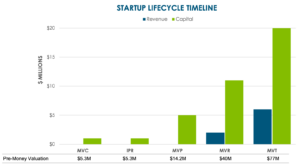Minimum Viable Traction (MVT) marks the final value inflection point, the end of the Traction GapTM.
Once you arrive there, congratulations! You have successfully traversed the Traction Gap, the most challenging period of time in an early stage startup’s journey to business success. You are now a member of a tiny group of startups that survive this process (less than 20%) and are ready for the go-to-scale phase. Break out the champagne and give your whole team a big pat on the back.
Securing Funding: Getting from Minimum Viable Repeatability (MVR) to Minimum Viable Traction (MVT)
Getting from Minimum Viable Repeatability (MVR) to Minimum Viable Traction (MVT) often requires a fresh round of capital, and often quite a lot of it.

Here are a few words on raising the capital to take you from MVR to MVT:
Your last capital raise (prior to Minimum Viable Product [MVP]) was based upon your team, the market opportunity, and some early customer/consumer wins. But this round will be based upon your business performance. Your valuation will be a function of your growth velocity, judged by your Customer Acquisition Cost (CAC), CAC ratio, gross margins, new customer attainment, churn rates, etc.
Whereas your last investor deck led with an overview that showcased the market opportunity and described how awesome your product was, your new investor deck must begin with and feature the performance of the business. Mid-to-later stage investors are interested in performance first; everything else is secondary. For this reason, a word to the wise: in your investor deck, have the details of the product itself come later. Start with an epic story about the grand vision, and then get right into the quantitative evidence. Why you are winning. This is what these investors will care about. Product demo and everything else should come later. This is unorthodox, but at Wildcat we’ve observed the successes and the failures of literally thousands of early stage startup presentations. We’ve seen what works and what doesn’t.
Many VCs won’t invest at MVR and want to wait until MVT. But there are true early stage investors out there. If you go in with the approach described here, you give yourself the best chance of securing some much-needed capital.
Are we there yet?
How do you know you’ve reached MVT?

Here’s a simple way to think about it: MVT = MVR plus multiple quarters of growth. There are lots of ways to measure growth: the obvious one is revenue, but you might also focus on engagement, downloads, usage or other metrics. It depends in large part on whether you are B2B, B2C, or B2B2C. However you measure it, if you’ve grown rapidly over the prior four to six successive quarters, then the market is accepting you. Your trajectory is up and to the right. For SaaS companies, about $6M ARR or $500K MRR is considered to be MVT.
Some reliable indicators that you’ve hit MVT are:
- You have released several versions of your product, and marketed and sold your offerings multiple times to companies or consumers. Internally, you’re feeling pretty confident about your skills on this front.
- You have demonstrated you can recruit and hire talented people into the organization, and there is solid team cohesion all round.
- You are able to reliably predict prospect conversion rates because you are building a historical track record of your startup’s pipeline and team’s performance. Your marketing and sales processes enable you to cost-effectively and reliably identify and acquire new customers each month.
Once you have reached MVT, you’re ready to really scale the business. But with success comes more work. Scaling means more capital, more people, and more technology. You’re at the point when many of the mid to late stage venture firms will aggressively reach out to see if you’re interested in taking on more capital v. you having to reach out to them. This is great, but it’s more work at a time when you’re also managing your ever-growing business and need to hit your target objectives. Bear in mind, as you reach MVT, the real scaling work is just beginning.
Your team has done incredible work, and you are in an exclusive club of survivors. But after MVT, if you want to match the growth rates of the most successful startups, your startup must prepare to triple the next year ($18M ending ARR), then double, year over year, for at least the next three years. This is typically the minimum amount of time—8 years—it takes to arrive at a liquidity event, whether an IPO or an acquisition.
The business challenges that arise after MVT are beyond the scope of the Traction Gap Framework. We always recommend Wildcat Partner, Geoffrey Moore’s classic work, Crossing the Chasm, to get a handle on the next phase.
This article is the eighth in a series of blog posts related to the Traction Gap, the challenging go-to-market phase where the vast majority of early stage startups — more than 80% — fail.
- To read the prior blog posts about the Traction Gap, click here.
- To get a copy of the book, “Traversing the Traction Gap”, click here.
To get a deeper understanding of the Traction Gap principles, check out these resources:


